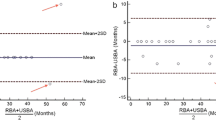Abstract
The purpose of this study was to establish a nomogram in order to predict limb length discrepancies in children with unilateral fibular hemimelia more accurately. In 31 children with unilateral fibular hemimelia the femoral-tibial length and skeletal age were determined an average of seven times per case by sequential radiographs during growth. From the data, a skeletal age nomogram was developed which shows a steeply declining mean skeletal age pattern in unilateral fibular hemimelia (the slope in girls was −0.59 and in boys −0.64). This nomogram crosses the normal mean skeletal age line of the Moseley straight-line graph at 10.5 years in girls and at 12 years in boys, and continues to decline until maturity. The results demonstrate an abnormal skeletal maturation process in patients with unilateral fibular hemimelia. The consistently declining steep skeletal age nomogram in unilateral fibular hemimelia makes prediction of skeletal maturity and limb length discrepancy inaccurate by the standard predictive methods particularly when using early skeletal ages. The skeletal age nomogram from our data determines skeletal maturation in children with unilateral fibular hemimelia more accurately, and allows a correct prediction of limb length discrepancy.


Similar content being viewed by others
References
Blair VP, Walker SJ, Sheridan JJ, Schoenecker PL (1982) Epiphyseodesis: a problem of timing. J Pediatr Orthop 2:281–284
Bowen RJ, Guille JT (1994) Critical evaluation of percutaneous epiphysodesis. Advances in operative orthopaedics, vol 2. Mosby-Year Book Inc. pp 341–355
Dewaele J, Fabry G (1992) The timing of epiphyseodesis. A comparative study between the use of the method of Anderson and Green and the Moseley chart. Acta Orthop Belg 58:43–47
Green WT, Wyatt G, Anderson M (1946) Orthoroentgenography as a method of measuring the bones of the lower extremity. J Bone Joint Surg Am 28:60–71
Lampe HIH, Swierstra BA, Diepstraten AFM (1992) Timing of physiodesis in limb length inequality. Acta Orthop Scand 63:672–674
Phemister DB (1933) Operative arrestment of longitudinal growth of bones in the treatment of deformities. J Bone Joint Surg Am 15:1–15
Porat S, Peyser A, Robin GC (1991) Equalization of lower limbs by epiphyseodesis: results of treatment. J Pediatr Orthop 11:442–448
Stephens DC, Herrick W, MacEwen GD (1977) Epiphyseodesis for limb length inequality. Clin Orthop 136:41–48
Bowen TRW, JR GJT, Choi IH (1991) Prospective evaluation of fifty-three consecutive percutaneous epiphyseodesis of the distal femur and proximal tibia and fibula. J Pediatr Orthop 11:350–357
Inan M, Chan G, Littleton AG, Kubiak P, Bowen JR (2008) Efficacy and safety of percutaneous epiphysiodesis. J Pediatr Orthop 28:648–651
Khoury JG, Tavares JO, McConnell S, Zeiders G, Sanders JO (2007) Results of screw epiphysiodesis for the treatment of limb length discrepancy and angular deformity. J Pediatr Orthop 27:623–628
Cundy P, Paterson D, Morris L, Foster B (1988) Skeletal age estimation in leg length discrepancy. J Pediatr Orthop 8:513–515
Eastwood DM, Cole W (1995) A graphic method for timing the correction of leg-length discrepancy. J Bone Joint Surg Br 77:743–747
Little DG, Nigo L, Aiona MD (1996) Deficiencies of current methods for the timing of epiphyseodesis. J Pediatr Orthop 16:173–179
Shapiro F (1982) Developmental patterns in lower-extremity length discrepancies. J Bone Joint Surg Am 64:639–651
Anderson M, Messner MB, Green WT (1964) Distribution of lengths of the normal femur and tibia in children from one to eighteen years of age. J Bone Joint Surg Am 46:1197–1202
Green WT, Anderson M (1960) Skeletal growth and the control of bone growth. Instr Lect Am Acad Orthop Surg 17:199–217
Greulich WW, Pyle SI (1959) Radiographic atlas of skeletal development of the hand and wrist, 2nd ed. Stanford University Press
Moseley CF (1977) A straight-line graph for leg-length discrepancies. J Bone Joint Surg Am 59:174–179
Paley D, Bhave A, Herzenberg JE, Bowen JR (2000) Multiplier method for predicting limb-length discrepancy. J Bone Joint Surg Am 82-A:1432–1446
Anderson M, Green WT, Messner MB (1963) Growth and predictions of growth in the lower extremities. J Bone Joint Surg Am 45:1–14
Moseley CF (1989) Assessment and prediction in leg-length discrepancy. Instr Lect Am Acad Orthop Surg 45:325–330
Kasser JR, Jenkins R (1997) Accuracy of leg length prediction in children younger than 10 years of age. Clin Orthop Relat Res 338:9–13
Shapiro F (1987) Longitudinal growth of the femur and tibia after diaphyseal lengthening. J Bone Joint Surg Am 69:684–690
Westh RN, Menelaus MB (1981) A simple calculation for the timing of epiphyseal arrest. A further report. J Bone Joint Surg Br 63:117–119
Aguilar JA, Paley D, Paley J, Santpure S, Patel M, Bhave A, Herzenberg JE (2005) Clinical validation of the multiplier method for predicting limb length at maturity, part I. J Pediatr Orthop 25:186–191
Aguilar JA, Paley D, Paley J, Santpure S, Patel M, Herzenberg JE, Bhave A (2005) Clinical validation of the multiplier method for predicting limb length discrepancy and outcome of epiphysiodesis, part II. J Pediatr Orthop 25:192–196
Kelly PM, Diméglio A (2008) Lower-limb growth: how predictable are predictions? J Child Orthop 2:407–415
Sharma M, MacKenzie WG, Bowen JR (1996) Severe tibial growth retardation in total fibular hemimelia after limb lengthening. J Pediatr Orthop 16:438–444
Author information
Authors and Affiliations
Corresponding author
Rights and permissions
About this article
Cite this article
Szőke, G., Mackenzie, W.G., Domos, G. et al. Possible mistakes in prediction of bone maturation in fibular hemimelia by Moseley chart. International Orthopaedics (SICOT) 35, 755–759 (2011). https://doi.org/10.1007/s00264-010-0988-6
Received:
Revised:
Accepted:
Published:
Issue Date:
DOI: https://doi.org/10.1007/s00264-010-0988-6




